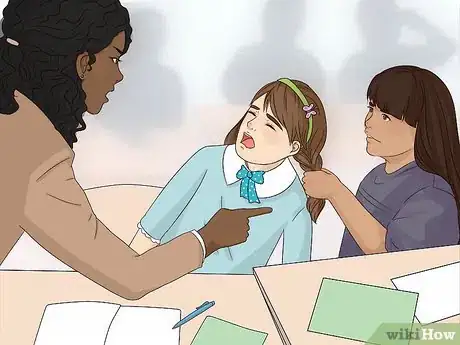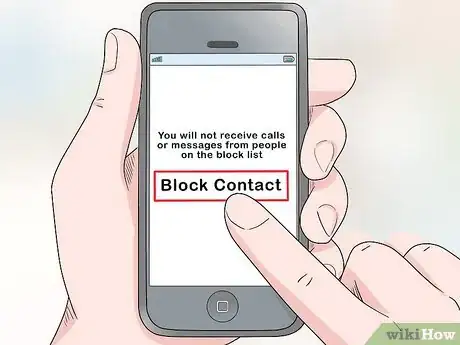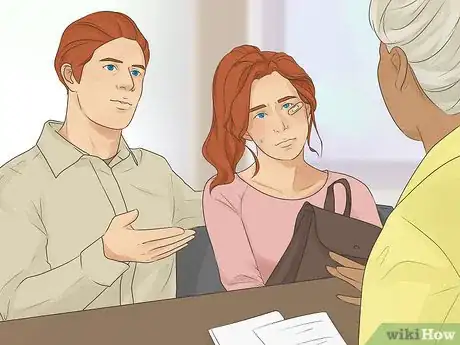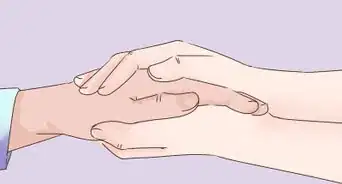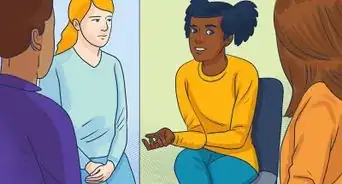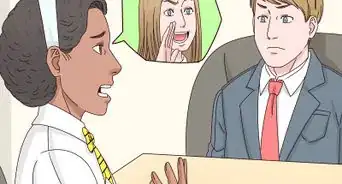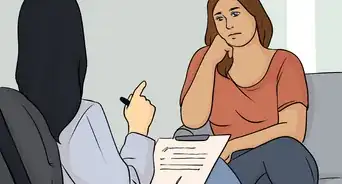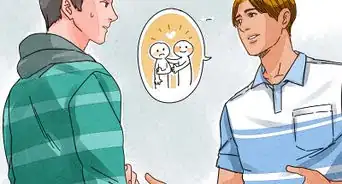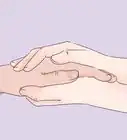This article was co-authored by Mental Health America. Mental Health America is the nation's leading community-based nonprofit dedicated to addressing the needs of those living with mental illness and promoting overall mental health for all. Their work is guided by the Before Stage 4 philosophy – that mental health conditions should be treated long before they reach the most critical points in the disease process.
wikiHow marks an article as reader-approved once it receives enough positive feedback. This article has 49 testimonials from our readers, earning it our reader-approved status.
This article has been viewed 1,054,877 times.
Bullying can take many forms, but all forms of bullying cause harm or worse. Even if there is no physical contact between a bully and their target, people who are bullied may carry the emotional damage of what they experienced for the rest of their lives. That is why it is important to put a stop to bullying. If you are being bullied, then there are things you can do to deal with the bully. If you witness bullying, then there are things you can do to stand up for someone else. You can also work to raise awareness among your peers and learn about the different ways that you can ask for help.
Things You Should Know
- Deal with a bully by walking away, reporting the bully, and asking them to stop if it’s safe. If you see someone being bullied, step in right away and separate them.
- Set a good example for others and stand up for people who need help. Talk to your school administrators if you need help or call law enforcement.
- Protect yourself from cyberbullying by keeping your passwords secret, blocking bullies, and reporting it to service providers.
Steps
Dealing with a Bully
-
1Walk away. If the situation seems threatening or dangerous, it's best to get away from the bully. Even if it is not a dangerous situation, remember that you don’t have to listen to someone saying mean things to you. The best thing to do might be to calmly walk away from the person. This will send the message that you won’t put up with this kind of treatment.
- Try to walk towards other people, such as towards a teacher or someone else who will not put up with bullying.
-
2Tell someone so the bully will stop. It's important to report bullying right away so that someone in authority can put a stop to it.[1] By telling someone that you are being bullied, you will be standing up for yourself and showing the bullies that you will not put up with their abuse.
- Find a teacher, parent, school counselor, or someone else who can help you and immediately tell them what the bully has been saying or doing to you. If the bullying occurs somewhere else, call the police or get a cop's attention if one is nearby.
- Try saying something like, “Joyce is bullying me. She keeps making fun of my weight and she will not stop. I have asked her to stop, but she is still doing it. I think I need some help to make it stop.”
- You can also write a note to explain what is happening. Deliver the note to your teacher, school counselor, or principal.
- Tell someone else if the first person you tell does not do anything about the bully. Don’t accept that you will have to put up with the bullying.
Tip: If you’re an adult dealing with bullying the workplace, talk to your supervisor or someone in human resources. You might find it helpful to keep a written record of your experiences or involve a third party who’s witnessed the bullying.[2]
Advertisement -
3Ask the bully to stop if you feel safe doing so. If you don’t feel physically threatened, using direct, assertive communication and body language is a good way to address a bully.[3] If a bully continues to harass you even after you have walked away, calmly let them know that you will not put up with the behavior. Turn and face the bully and tell them to stop.
- Don’t try to confront the bully if you feel like doing so might put you in danger.
- To use assertive body language, stand up tall and face the bully. Look the bully in the eye when you are speaking to them. Don’t look down and don’t try to make yourself smaller, such as by folding your arms or bringing your knees in close to your body. Pull yourself up to your full height, keep your arms at your sides, and your feet about shoulder width apart.
- Keep your request short and direct. Try saying something like, “Stop it, Jennifer,” or, “Cut it out, Craig.” As you say this, make sure that you look the bully directly in the eye and speak in a calm, clear voice.
- Don’t compliment or insult the bully. If you say nice things to a bully after they have been insulting you, putting you down, or physically threatening you, then this will only increase their sense of power. Calling the bully names may enrage them and increase their efforts to hurt you.
-
4Stay calm. It is the bully’s goal to get an emotional response out of you, so do your best to keep calm and avoid showing them how you feel. Try your best not to show that you are angry, sad, or frightened. The bully may feed off of these emotions and increase their efforts.
- Take a few deep breaths and think about something that makes you happy, such as getting a good grade on a test, playing with your dog, or something fun that you are planning to do with your family over the weekend. Doing this may help you to take a step back from the situation and avoid reacting to your emotions. Make sure that you keep your eyes open and maintain eye contact with the bully as you do this.
- Respond to the bully in a calm way. For example, you might say, "Jack, I know you think you're funny, but you're not. Stop." Or, "Stop now or I'm asking the teacher to move you away from me."
- Be sure to talk about how the bully made you feel with someone else later on. Talk with your parents, a school counselor, or a teacher.
Helping Someone Who Is Being Bullied
-
1Take immediate action. Do not wait to deal with bullying. If you see or hear about someone being bullied, then step in to stop the bullying right away. If you cannot intervene yourself, then find someone who can. If you’re an adult intervening in a bullying situation, you may also want to get help from a second adult.[4]
- You can try standing up for the person and saying something like, “Stop it, Lisa!” Don’t insult the bully or use physical force to stop them from bullying the person.
- If you are not able to intervene or if intervening does not work, then get help from someone. For example, if you see someone being bullied on the playground, then run and get a teacher or recess monitor and tell them what is happening.
- Don’t wait until later to tell someone. If you wait, the person may get hurt.
- Tell a teacher or counselor about any ongoing bullying that you know about. Some forms of bullying, such as exclusion or subtle remarks, may go unnoticed by teachers.
-
2Separate the bully and the person being bullied if you can. It is important to keep the bully away from the person they are bullying. If you’re helping a peer who is being bullied, go with them to a safe space away from the bully. If you’re an adult trying to stop a bullying situation, do not force the two parties to be in the same room together or to shake hands and make up. Put them in separate rooms and talk with each one individually.[5]
- Ask each person what happened.
- You can also talk to other kids who witnessed the bullying, but don’t do this in front of the bully or the person who was being bullied.
- If you didn’t witness the bullying yourself, take your time sorting out the details of what happened. Do not try to figure everything out on the spot. Talk with both parties if you can, ask witnesses what they saw, and then put all of the pieces together.
-
3Take bullying seriously. Bullying is a serious problem that can escalate and cause serious damage if it is not stopped. Take any bullying that you see or hear about very seriously, and don’t hesitate to tell someone who can help.[6] You might even need to contact the police or call emergency services in some situations. You may need to involve the police or seek medical attention for the person if:[7]
- A weapon is involved.
- There are threats involved.
- The violence or threats are motivated by hate, such as racism or homophobia.
- The bully has done serious physical harm to the person.
- Sexual abuse is involved.
- Anything illegal has happened, such as blackmail or robbery.
Did you know? The harmful effects of bullying can be severe and long-term. Kids who experience bullying are more likely to struggle with depression, anxiety, and panic disorders as they get older.[8]
Setting a Good Example
-
1Make sure you aren't participating in bullying behavior at school. Examine your own treatment of your classmates. Is there anyone you may be bullying, even unintentionally? If you ever pick on someone, even if you wouldn't consider it bullying, you should stop. Try to be nice to everyone, even if they're not your friend.
-
2Stand up for people if they're being bullied. If you see someone getting bullied in your school, stand up to the bullies. Not participating isn't going far enough. Make sure that you are actively taking a stand to prevent the victim from getting harmed further. You can interfere by speaking with the bully if you feel safe doing so, or telling a school administrator what you saw.
- If your friends start gossiping about someone, make it clear that you don't participate in that kind of thing. Try saying something like, “I don’t like gossip. Can we talk about something else?”
- If you're part of a group that's intentionally leaving someone else out, tell the group you want to include everyone, because it's the right thing to do. Try saying something like, “I think we should be nicer to Catherine. It must be hard to be the new girl in school.”
- If you see someone getting picked on and fear for that person's safety, tell a teacher or school administrator right away. Try saying something like, “I am worried about David. I have noticed that some of the older boys harass him when he is walking home from school.”
-
3Spread the word that bullying has to stop. Many schools have anti-bullying campaigns led by students who want to keep their schools safe and friendly. Join a group or start one at your school to spread awareness about the problem of bullying and figure out ways to solve it.
- Try starting a conversation with your friends about bullying. You might say something like, “Did you know that bullying is still happening at our school? I think it is terrible and I would like to do something to stop it.”
- Talk with your teacher or school counselor about ways you can help. For example, you might be invited to give a presentation on bullying in your class or you might be able to help organize an event to raise awareness about bullying.
You can be an anti-bullying influencer. By taking a stand against bullying at your school or in your peer group, you can make a real difference! Studies show that bullying incidents drop significantly when schools put student-led anti-bullying programs in place.[9]
Protecting Yourself from Cyberbullying
-
1Think about what you post. You never know what someone will forward. Being kind to others online will help to keep you safe. Do not share anything that could hurt or embarrass anyone.
- Think about who sees what you post online. Complete strangers? Friends? Friends of friends? Privacy settings let you control who sees what.
-
2Keep your password a secret from other kids. Even kids that seem like friends could give your password away or use it to hack you and get your personal info. Let your parents have your passwords.
-
3Report cyberbullying to service providers. This form of bullying has become so common that phone services and other service providers also have plans in place for dealing with abuse. Ask your parents to call your service providers to report online or phone-based bullying so that they can take action to block the person from continuing to contact you. You may have to provide phone or email records to the service provider.
-
4Block the bully. Put an end to the bully’s ability to harass you online by blocking them from communicating with you. Take the following steps to protect yourself:
- Block the bully on instant messaging and email.
- Unfriend and block the person on your social network accounts and use the online privacy settings to ensure that the person can’t contact you again.
- Block the person's phone number to stop intimidating texts and phone calls.
-
5Talk to an adult you trust about any messages you get, or things you see online that make you sad or scared. Keep your parents in the loop. Tell them what you’re doing online and who you’re doing it with. Let them friend or follow you. Listen to what they have to say about what is and isn’t okay to do. They care about you and want you to be safe.
Asking for Help
-
1Talk to your school administrators. Since bullying is so common, every school has a policy for handling it efficiently and effectively. Talk to your school principal or school counselor about the situation so that it stops as soon as possible. Steps will be taken to either punish the bully or set up mediation to resolve the issue.
- Know that other kids in your school are experiencing the same problem, and rules and protocols are in place for good reason.
- If you're a parent, set up a meeting with the school administrator instead of trying to handle the situation on your own.
-
2Call local law enforcement. Certain forms of bullying can be quite dangerous, and some are even classified as crimes. If the bullying you experience involves one of these elements, call your local police department.
- Physical violence. Bullying can lead to real physical harm. If you're worried that your health or life is in danger, call the police.
- Stalking and use of intimidation. If someone is violating your personal space and intimidating you, that's a crime.
- Death threats or threats of violence.
- Sharing of potentially humiliating photos or videos without your consent, including sexually explicit photos or videos.
- Hate-related actions or threats.
Tip: If you’re a kid experiencing this kind of bullying in school, try asking an adult (such as a teacher, administrator, or playground monitor) for help, first. If the bullying takes place outside of school, you may need to call the police directly, or ask an adult to call for you.
Warnings
- Continued bullying that causes severe emotional or physical damage may be grounds for taking legal action. If you’re an adult dealing with severe bullying, or if your child is being bullied and the measures taken by the school and the bully's parents are not sufficient to correct the problem, you might want to consider getting a lawyer involved.⧼thumbs_response⧽
References
- ↑ http://www.kzoo.edu/psych/stop_bullying/for_kids/what_is_a_bully.html
- ↑ https://www.psychologytoday.com/us/blog/communication-success/201611/8-keys-handling-adult-bullies
- ↑ https://www.psychologytoday.com/blog/passive-aggressive-diaries/201503/what-girls-can-say-and-do-stand-bullying
- ↑ http://www.stopbullying.gov/respond/on-the-spot/index.html
- ↑ http://www.stopbullying.gov/respond/on-the-spot/index.html
- ↑ http://kidshealth.org/en/parents/bullies.html
- ↑ http://www.stopbullying.gov/respond/on-the-spot/index.html
- ↑ https://www.sciencenewsforstudents.org/article/bullying-hurts-peer-support-really-helps
- ↑ https://www.sciencenewsforstudents.org/article/bullying-hurts-peer-support-really-helps
About This Article
To stop someone bullying you, try to walk away from the situation to distance yourself from them. If they don’t let you leave or they continue to harass you, try to stay calm and tell them to leave you alone. For example, you can say something like, “Stop it, Craig. You’re bothering me.” However, if you feel physically threatened by a bully, you don’t have to deal with them alone. Tell a teacher, parent, or counselor as soon as possible, who will help you put a stop to the bullying. It's not always easy, but try your best to ignore bullies, since they're probably just trying to get a reaction out of you. For more tips from our Mental Health co-author, including how to help someone else who is being bullied, read on!




